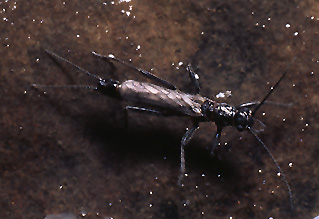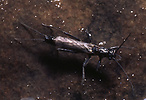Allocapnia
C. Riley Nelson


This tree diagram shows the relationships between several groups of organisms.
The root of the current tree connects the organisms featured in this tree to their containing group and the rest of the Tree of Life. The basal branching point in the tree represents the ancestor of the other groups in the tree. This ancestor diversified over time into several descendent subgroups, which are represented as internal nodes and terminal taxa to the right.

You can click on the root to travel down the Tree of Life all the way to the root of all Life, and you can click on the names of descendent subgroups to travel up the Tree of Life all the way to individual species.
For more information on ToL tree formatting, please see Interpreting the Tree or Classification. To learn more about phylogenetic trees, please visit our Phylogenetic Biology pages.
close boxIntroduction
The genus Allocapnia is restricted to eastern North America, extending from the Great Plains to the Atlantic Coast. Many are wingless, especially the males. The benchmark revision by Ross and Ricker (1971) contains a vast amount of information regarding this interesting genus.
Characteristics
Synapomorphies for Allocapnia: epiproct snap-like (Ross & Ricker 1971), shared with Capnia vidua from Europe. Allocapnia differs from C. vidua in having a dorsal process on the eighth ternite of the male and in the pattern of sclerotization of the male ninth segment.
References
Hennig, W. 1966. Phylogenetic systematics. Univ. Illinois Press, Urbana. 263 pp.
Ross, H. H. & W. E. Ricker. 1971. The classification, evolution, and dispersal of the winter stonefly genus Allocapnia. Illinois Biological Monographs 45: 1-166.
Zwick, P. 1973. Insecta: Plecoptera. Phylogenetisches System und Katalog. Das Tierreich 94. Walter de Gruyter and Co., Berlin. 465 pp.
Title Illustrations

| Scientific Name | Allocapnia |
|---|---|
| Location | Arkansas |
| Specimen Condition | Live Specimen |
| Copyright |
© 1996
C. Riley Nelson

|
About This Page
C. Riley Nelson

Brigham Young University, Provo, Utah, USA
Page copyright © 1996 C. Riley Nelson
All Rights Reserved.
Citing this page:
Nelson, C. Riley. 1996. Allocapnia. Version 01 January 1996 (under construction). http://tolweb.org/Allocapnia/14102/1996.01.01 in The Tree of Life Web Project, http://tolweb.org/







 Go to quick links
Go to quick search
Go to navigation for this section of the ToL site
Go to detailed links for the ToL site
Go to quick links
Go to quick search
Go to navigation for this section of the ToL site
Go to detailed links for the ToL site